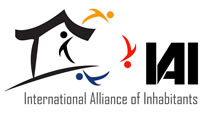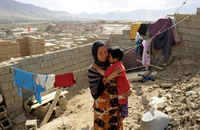Still at risk: the forced eviction of displaced people in urban Afghanistan
A new IDMC report highlights how thousands of displaced families in towns and cities across the country are living with the threat of being forcibly evicted. While the new IDP Policy offers hope for the long-term, immediate action is now needed by Afghan authorities and humanitarian and development partners to domesticate its provisions so as to ensure secure and dignified housing conditions for all of Afghanistan’s displaced.
In Afghanistan, some 630,000 people are currently displaced due to ongoing armed conflict. Furthermore, the country still struggles with reintegrating over 5.7 million former refugees. As Afghans face a critical period of political and security transition in 2014, helping internally displaced people (IDPs) and returned refugees find long term solutions remains inextricably linked to guaranteeing their rights to housing, land and property.
Urban growth not matched by adequate policy-making
Up to 30 per cent of Afghans now live in towns and cities, and urban population growth in Afghanistan is well above averages elsewhere in Asia. Kabul’s population alone has doubled from two million in 2001 to 4.5 million in 2010 and is projected to reach an estimated six million by 2020. The majority of urban dwellers live in informal – or unplanned – settlements in or around the major cities of Kabul, Herat, Mazar-e-Sharif, Jalalabad and Kandahar.
Without affordable housing options, vulnerable families, both IDPs and former refugees who have returned to Afghanistan, occupy private and public land in and around major cities without permission or without recognised land deeds. This exposes them to sub-standard living conditions and the constant fear of forced eviction by landowners or government authorities seeking to remove them from the land to make way for urban development projects.
The main option presented to IDPs and returnees who face eviction is through the government’s 2005 Land Allocation Scheme (LAS), where plots of land were set aside to re-house displaced communities. However, there is little evidence of people relocating for the long-term to these sites which frequently offer worse living conditions and are relatively more expensive.
In urban areas, more effective laws and regulations are needed to regulate informal settlements and provide peace of mind for the men, women and children who live there. But municipal and national authorities have been reluctant to acknowledge informal settlements, arguing that they should be demolished rather than improved and legalised.
This situation is compounded for the internally displaced population, because their right to choose their place of settlement has not been recognised and authorities continue to consider urban IDPs as a temporary phenomenon. Yet IDMC evidence shows that IDPs rarely wish to leave the towns and cities where they live, rendering the government’s preference to return those displaced back to their original “home” unsustainable.
Welcome, but insufficient, progress for urban IDPs
There are welcome signs, however, that official attitudes towards the urban displaced are shifting. In 2012, the humanitarian community drafted guidelines to prevent forced evictions and mitigate the harm and suffering they cause. These were later incorporated into Afghanistan’s landmark National Policy on Internal Displacement, which was adopted by the government in November 2013.
The policy is a significant step towards addressing gaps in protection and longer-term assistance for IDPs. It recognises their rights to secure and dignified housing as well as the right to settle where they choose. Importantly, it also highlights the responsibility of Afghan authorities at all levels – municipal, provincial and national – to protect the increasing number of urban IDPs and refugee returnees who live in informal settlements, including from the threat of forced eviction.
4 Next steps to prevent forced evictions
Forced evictions need not be an inevitable result of IDPs and refugee returnees living in cities. The Government of Afghanistan should, with international support:
- Take immediate steps to implement the IDP Policy
- Introduce comprehensive laws, policies and plans to prevent and sanction forced evictions of urban IDPs, refugee returnees and the broader urban poor
- Ensure genuine consultation and participation of affected communities, together with humanitarian and development agencies assisting them
- Introduce measures to provide legal security of tenure to vulnerable urban IDPs, returnees and others with no legal access to land and housing
The international community, too, cannot drop the ball now. While there have been good initiatives by individual agencies to ensure that Afghans have access to adequate urban housing, a comprehensive response is needed for the displaced which can bridge gaps between short term aid and long term solutions. In particular, international donors and the UN must provide sustained support for the implementation of the new IDP policy and ensure that there is an adequate focus on durable solutions in the UN’s development planning.
The large numbers of internally displaced and returning refugee families living in Afghan towns and cities today pose both a protection and an urban development challenge. The country’s landmark IDP policy now offers them a chance of real transition. Facing an unpredictable future in 2014, Afghanistan has no time to waste in making its provisions a concrete reality.
For IDMC’s full recommendations read the IDMC report “Still at risk: the forced eviction of IDPs and refugees returnees in urban Afghanistan .”
Place à laquelle s'applique cet article
Commentaires
%login_link_starAuthentifiez vous ou créez un nouveau compte utilisateur pour commenter.

